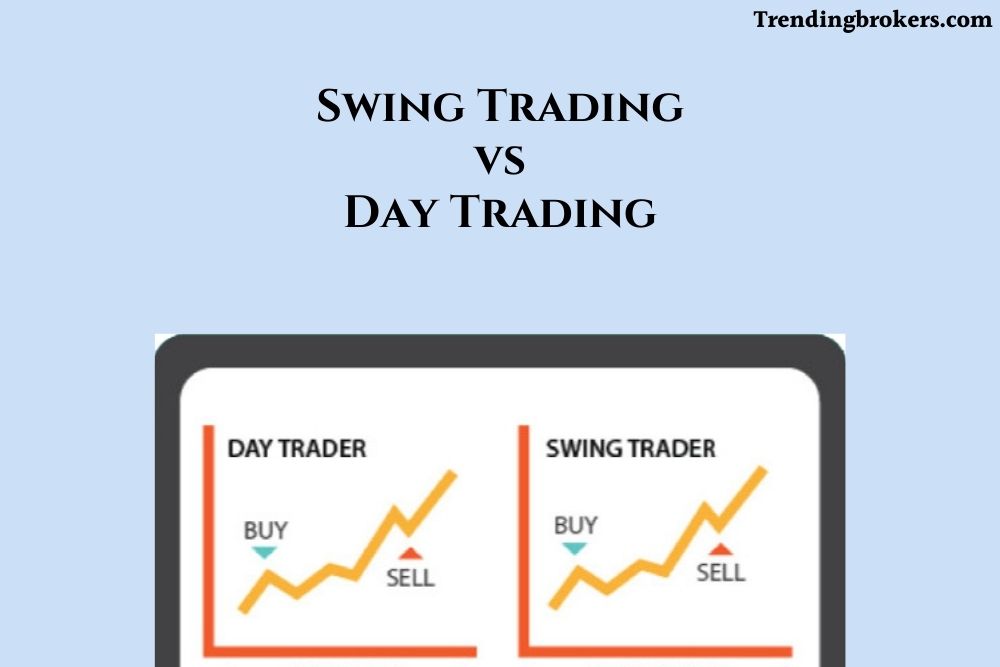“Day trading vs Swing trading” – the comparison between these two popular strategies has now become one of the long-standing discussions amongst active traders. The reasons can be said to be their widespread adoption and the high degree of attention they receive. While many traders prefer the former, others choose the latter.
Both strategies have their own advantages and disadvantages, and depending on various factors such as risk tolerance and trading goals, one may be better suited than the other.
In this blog, we’ll explore the key differences between Day trading vs Swing trading, as well as a detailed overview of each strategy. By the end of this post, you should have a clearer understanding of these two popular trading strategies and be able to make an informed decision on which one aligns best with your investment goals.
Day Trading vs Swing Trading: Detailed Overview Of Each Strategy
Explanation Of Swing Trading
Swing trading or momentum trading can be defined as a trading strategy that involves holding trade positions for a few days up to a few weeks, with the goal of capturing short-to-medium-term price movements in stocks, commodities, or currencies.
The objective of a swing trader is to identify and profit from the natural “swings” or fluctuations in the market. Compared to day trading, swing trading requires less time and attention from the trader, as trades can be held for days or even weeks.
This makes it a more suitable option for those who don’t want to make trading a full-time profession. However, swing trading still requires a certain level of knowledge and investment capital, as leverage requirements are higher than those of day trading.
One advantage of swing trading is that it allows traders to capture higher profits than they would in day trading, as positions are held for a longer time-frame. Additionally, swing traders can set stop-loss to limit their potential losses in case the market moves against them.
Despite its advantages, swing trading is not without risks. Swing traders need to be aware that there is always a risk of significant losses, especially if they hold positions for an extended period. It is important to have a sound trading plan, proper risk management strategies, and a good understanding of the market before engaging in swing trading.
Read our Blog- Find which indicators are best for swing trading.
Explanation Of Day Trading
Day trading or Intraday trading is one of the widely-used trading strategies in which traders buy and sell financial assets, such as stocks, commodities, or currencies, within the same day.
Day traders use technical analysis and complex charting systems to identify stocks & other financial assets to make quick & numerous small profits on multiple trades. The ultimate goal of day trading is to make enough profits by buying assets at their lowest selling price and selling them at higher to cover any losses and earn a living from trading.
Unlike swing traders, day traders do not hold any positions or own any assets overnight or for an extended period. Day traders need to have the necessary skills and qualities, such as decisiveness, discipline, and expertise, to succeed in this type of trading.
However, day trading can be risky, and many traders suffer significant financial losses in the first month of trading, and many never become profitable, as per data from the U.S. Securities and Exchange Commission (SEC).
Day trader typically works independently, outside of the corporate world, with a flexible schedule and the ability to work at their own pace. However, day trading requires a lot of focus and attention, and traders need to be willing to take risks and handle the emotional stress that comes with it.
A day trader should only risk money they can afford to lose, as many traders have lost significant amounts of borrowed funds, putting them in debt and potentially ending their day trading career.
Understanding The Key Differences Between Day Trading vs Swing Trading
Both trading strategies are unique, and traders can select the one that supports their trading goal. It depends on the traders’ skills, trading style, technical analysis, lifestyle, and preferences.
Day trading has its advantages and disadvantages, while the same follows with swing trading. To make the process of choosing which one works well with your trading style, we have listed out some key differences between Day Trading vs Swing Trading:
Trade Frequency
Swing traders trade for days, weeks, or months while day traders are confined to same-day trade. They can have multiple or single trade positions in day trading.
Transactions
The number of transactions also varies for both, as swing traders hold fewer transactions in comparison to day trading.
The trade transactions in swing trading are for days or more, and traders follow the investment to have the best possible results. But, a day trader invest regularly; therefore, the number of transactions is more.
Time Required
Trading in swing involves days, weeks, and months to trade, so the time taken is more. In contrast, day trades are for a single day and could vary for every trader.
Some may have one hour trade, others may go for a few minutes trade, and it could be a day’s investment.
So, time is a significant factor in these trading techniques. Traders can select the best one and have a smooth trading experience.
Trading Time
Investing in day trading is continuous until trading hours end, and traders have to be alert and frequent with their trading. While swing trading is not continuous and could be traded easily over time. Swing traders enter and exit the market during longer trends.
Day trading is a full-time job that requires constant monitoring and continues till the market hours, but swing trading is part-time trading. This makes them different from each other, and their trading also diversifies.
Day Trading vs Swing Trading: Capital Requirements
The capital requirement for day trading and swing trading can vary depending on a number of factors, including the strategy, risk management approach, and the amount of leverage used.
Stock Trading
Day trade stocks in the U.S. require an account surplus of, in any event, $25,000. However, no lawful least minimum amount exists for swing trades in the stock market. Nonetheless, a swing trader will probably need to have, in any event, $10,000 in their account and, ideally, $20,000 if they are hoping to draw pay from trading. However, day trading incurs higher transaction fees.
Forex
There is no minimum amount that exists to day trade the forex market. It is suggested that traders should start with $500, yet ideally, $1,000 or more. To swing trade forex, the base suggested sum is about $1,500; however, ideally, more. This measure of capital will permit you to place multiple trades all at once.
Futures
For day trading futures, start with $5,000 to $7,500. These sums rely upon the futures contract being traded.
Thus, in day trading, a few agreements could require substantially more capital, while a couple of agreements, like miniature agreements, may require less.
To swing trade an assortment of futures contracts, you need at least $10,000 and likely $20,000 or more. The sum required relies upon the edge necessities of the particular agreement being traded.
Day Trading vs Swing Trading: Which One Should You Choose?
When choosing between day trading and swing trading, there are several factors to consider, including stress, speed, concentration, and opportunity.
Day trading involves more pressure and requires sustained attention for extended periods due to the fast-paced nature of the activity and short-term market movements. It may be a good choice for those who thrive under pressure and can handle the demands of trading for several hours per day.
On the other hand, swing trading is a higher profit potential strategy that can be less stressful and allows for a more relaxed trading style. It involves holding multiple positions for several days to weeks, which means there is less pressure to make quick decisions and react to market movement.
In terms of speed, day trading can be very fast-paced, while swing trading allows for a more leisurely approach. Day traders need to be able to react quickly to changes in the market, while swing traders can take a more measured approach to decision-making.
Concentration is another factor to consider. Day trading requires sustained focus for extended periods, while swing trading involves focusing on longer-term trends and positions. Both styles require concentration, but day trading can be more mentally demanding due to the speed and intensity of the activity.
Finally, the opportunity is another consideration. Swing trading can offer more flexibility in terms of time commitment, allowing swing traders to pursue other interests or activities outside of trading. Day trading requires more time and attention, which may limit other opportunities.
Ultimately, the choice between day trading and swing trading will depend on the individual trader’s personality, goals, and trading style. It is important to carefully consider these factors and develop a sound trading plan before committing any capital to trading activities.
Final Words On Day Trading vs Swing Trading
When considering whether to pursue day trading vs swing trading, it ultimately depends on the individual trader’s goals, personality, and trading style. Day trading involves higher risk and more pressure due to the need for quick decision-making, while swing trading is more relaxed and focuses on holding positions for several days to weeks and can be used in conjunction with momentum indicators.
Whether you choose day trading or swing trading, it is important to have a sound trading plan, risk management strategy, and access to a reliable & registered broker. Capitalix is one such trusted online trading platform that offers a range of tools and resources, felicitating both day trading and swing trading. You can also practice by placing a few virtual trades on its free demat account offering. So, open your brokerage account today.
Risk Warning: It is highly advisable to regularly scrutinize the consolidated account statement issued by NSDL/CDSL every month to monitor the status of your securities, mutual funds, and bonds and ensure their accuracy.
FAQs
Is Swing Trading Better Than Day Trading?
This depends on individual preferences and trading styles. Swing trading typically involves holding positions for several days to weeks, while day trading is a short-term trading strategy that requires quick decision-making and can result in more significant gains or losses and can be taken as a full-time job. Both trading styles require discipline and a sound trading plan, but the choice between the two ultimately depends on the trader’s goals and personality.
Are Swing Traders More Successful Than Day Traders?
Again, this depends on the individual trader’s skills and strategies. Swing trading and day trading both have the potential to be successful, but it requires practice, discipline, and a solid trading plan. Ultimately, success in trading is determined by consistently following a profitable strategy and managing risk effectively.
Is Swing Trading Riskier Than Day Trading?
Both swing trading and day trading involve risk, but the level of risk depends on individual traders’ strategies, experience, and discipline. Unline day trading, swing trading involves holding positions for a more extended period, which means traders may be exposed to more significant market volatility, while day trading can be more stressful and require quick decision-making under pressure. If you’re a person who doesn’t like to take risks, you can go with more secured mutual fund investments.
Day Trading vs Swing Trading: Which Is The Most Profitable Trading Strategy?
Again, this depends on individual trading style, experience, and daily volatility of the financial markets. Both trading methods have the potential to be profitable, but it requires discipline, a sound trading plan, and a comprehensive understanding of the securities markets. Successful trading is about consistently following a profitable strategy and managing risk effectively
What Is The Major Difference Between Day Trading vs Swing Trading?
The key difference between day trading and swing trading is the length of time positions are held. Day trading involves opening and closing positions within a single trading day, while swing trading involves a holding period of several days to weeks. Day trading requires quick decision-making and can be more stressful, while swing trading requires patience and discipline.
What Is A Pattern Day Trader?
A stock trader who executes four or more numerous trades within a five days period using a margin account is termed as Pattern day trader by US securities and exchange commission. These types of traders have to sit in front of a computer screen for hours.


